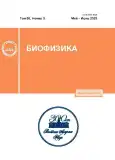Luminescent diagnostics and quantitative assessment of malaria based on a lateral flow immunoassay with cdte quantum dots
- 作者: Chauhan H.1, Jariwala A.1, Kheraj V.1
-
隶属关系:
- Sardar Vallabhbhai National Institute of Technology
- 期: 卷 68, 编号 3 (2023)
- 页面: 616-624
- 栏目: Articles
- URL: https://journals.rcsi.science/0006-3029/article/view/144463
- DOI: https://doi.org/10.31857/S0006302923030237
- EDN: https://elibrary.ru/FTTHTS
- ID: 144463
如何引用文章
全文:
详细
作者简介
H. Chauhan
Sardar Vallabhbhai National Institute of TechnologyGujarat, India
A. Jariwala
Sardar Vallabhbhai National Institute of TechnologyGujarat, India
V. Kheraj
Sardar Vallabhbhai National Institute of Technology
Email: vk@phy.svnit.ac.in
Gujarat, India
参考
- X. Shi and Z. Wang, Rev. Med. Microbiol., 32 (3), 183 (2021).
- P. Liu, Y. Zhou, M. Guo, et al., Nanoscale, 10, 848 (2018).
- N. H. T. Tran, K. T. L. Trinh, J. H. Lee, et al., Small, 14, 1801385 (2018).
- R. Fan, W. Zhang, Y. Jin, et al., Microchim. Acta, 187, 1 (2020).
- Y. Liang, X. Huang, R. Yu, et al., Anal. Chim. Acta, 936, 195 (2016).
- G. Liu, J. Zhao, S. Wang, et al., Sensors and Actuators B: Chemical, 306, 127583 (2020).
- S. Wang, C. Zhang, and Y. Zhang, Biosensors and Biodetection, Ed. by A. Rasooly and K. E. Herold (Humana Press, 2009), vol. 504.
- Y. Jeong, Y. M. Kook, K. Lee, and W. G. Koh, Biosens. Bioelectron., 111, 102 (2018).
- S. M. Fothergill, C. Joyce, and F. Xie, Nanoscale, 10, 20914 (2018).
- G. A. Posthuma-Trumpie, J. Korf, and A. Van Amerongen, Anal. Bioanal. Chem., 393, 569 (2009).
- X. Gao, L. P. Xu, S. F. Zhou, et al., Am. J. Biomed. Sci., 6, 41 (2014).
- I. Y. Goryacheva, P. Lenain, and S. De Saeger, Trends Analyt. Chem., 46, 30 (2013).
- O. A. Aladesuyi and O. S. Oluwafemi, Nano-Structures & Nano-Objects, 24, 100568 (2020).
- Z. Li, P. Huang, J. Lin, et al., J. Nanosci. Nanotechnol., 10, 4859 (2010).
- Z. Wang, J.Ruan, and D. Cui, Nanoscale Res. Lett., 4, 593 (2009).
- D. Cui, B. Pan, H. Zhang, et al., Anal. Chem., 80, 7996 (2008).
- M. Sajid, A. N. Kawde and M. Daud, J. Saudi Chem. Soc., 19, 689 (2015).
- H. Yang, D. Li, R. He, et al., Nanoscale Res. Lett., 5, 875 (2010)
- J. Zhang, Y. Wei, S. Qiu, and Y. Xiong, Spectrochim. Acta, Part A: Mol. Biomol. Spectrosc., 247, 119107 (2021).
- U. Resch, H. Weller, and A. Henglein, Langmuir, 5, 1015 (1989).
- T. Lu, K. D. Zhu, C. Huang, et al., Analyst, 145, 76 (2020).
- World malaria report 2020: 20 years of global progress and challenges (World Health Organization, Geneva, 2020). Licence: CC BY-NC-SA 3.0 IGO, https://www.who.int/publications/i/item/9789240015791.
- D. Bell, C. Wongsrichanalai, and J. W. Barnwell, Nat. Rev. Microbiol., 4, 682 (2006)
- A. L. Rogach, L. Katsikas, A. Kornowski, et al., Ber Bunsen Phys Chem., 101, 1668-70 (1997).
- N. Liu and P. Yang, Luminescence, 29 (6), 566 (2014).
- S. Subramanian, S. Ganapathy, M. Rajaram, and A. Ayyaswamy, Materials Chemistry and Physics, 249, 123127 (2020).
- R. Carcione, F. Limosani, and F. Antolini, Crystals, 11 (3), 253 (2021).
- W. W. Yu, L. Qu, W. Guo, and X. Peng, Chem. Mater., 15, 2854 (2003).
- T. Kondratenko, O. Ovchinnikov, I. Grevtseva, et al., Materials, 13, 909 (2020).
- J. Tashkhourian, G. Absalan, M. Jafari, and S. Zare, Spectrochim. Acta A: Mol. Biomol. Spectrosc., 152, 119 (2016).
补充文件









